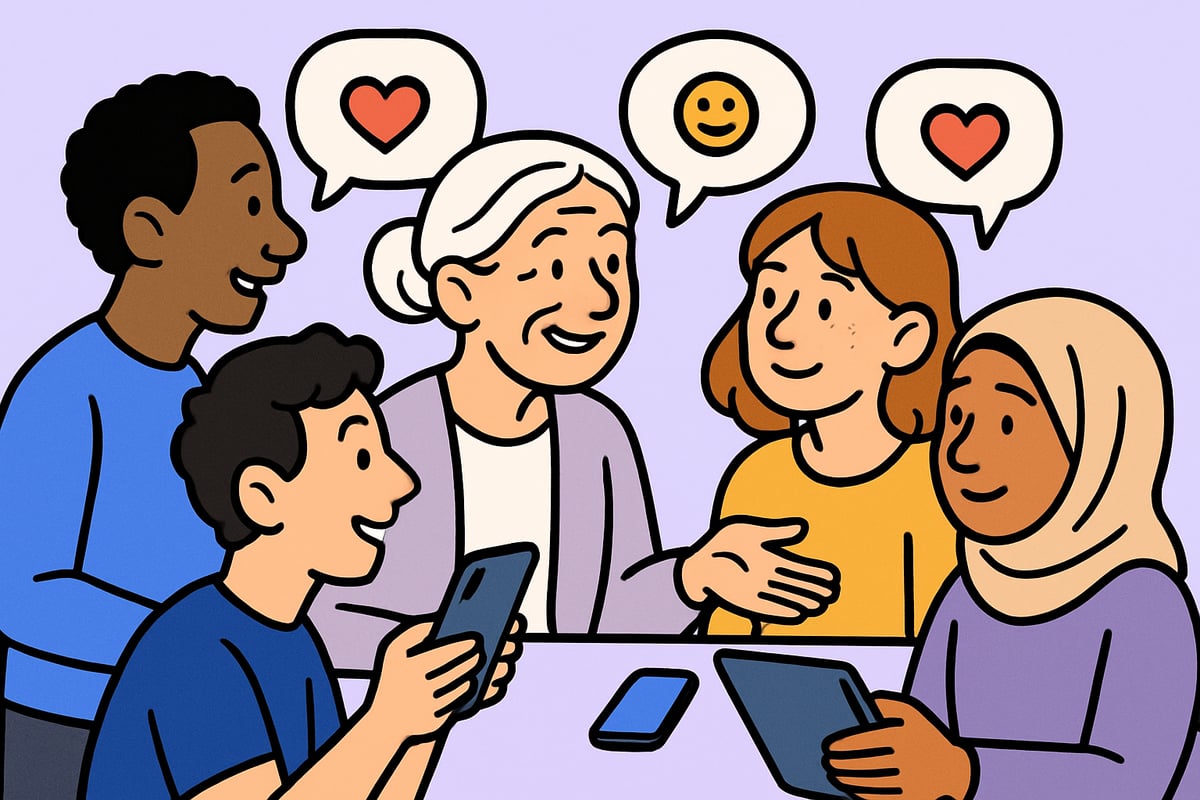Guide to Emotional Conversation: Master Connection in 2025
In today's fast-paced digital world, many of us feel more connected yet lonelier than ever. The ability to master emotional conversation is becoming the secret ingredient to building real, lasting relationships in 2025.
Did you know that 83% of people say their days feel warmer and more fulfilling after an authentic chat? This guide is here to help you unlock the power of emotional conversation, so you can navigate tough talks, deepen bonds, and create genuine trust.
You’ll discover the science behind how we connect, step-by-step methods for effective dialogue, and expert tips for both digital and face-to-face conversations. Ready to transform your connections and grow in every area of life? Dive in and start your journey to mastering emotional conversation today.
The Science of Emotional Conversation in 2025
Understanding the science behind emotional conversation unlocks the door to stronger relationships and deeper connection. As we move through 2025, the ability to communicate with empathy and awareness is more important than ever.

Understanding Emotional Intelligence
Emotional intelligence, or EQ, is the foundation of every meaningful emotional conversation. It consists of four main components: self-awareness, self-regulation, empathy, and relationship management. Together, these skills shape how we understand, express, and navigate emotions during interactions.
Here is a quick summary:
Component | Description |
|---|---|
Self-awareness | Recognizing your own emotions |
Self-regulation | Managing your emotional responses |
Empathy | Understanding others’ feelings |
Relationship management | Building and maintaining healthy connections |
Research shows that high EQ correlates with professional success and satisfying relationships. In fact, demand for emotional skills in the workplace has surged by 20 percent, reflecting their growing value. Leaders with strong EQ retain their teams and guide them through change more smoothly than those who lack it.
To learn more about these skills, see this overview of the Emotional Intelligence Components.
The Impact of Technology on Human Connection
Technology has transformed the landscape of emotional conversation. Digital tools like messaging apps, video calls, and social platforms have made it easier to connect, but they also create new barriers.
While we are more connected digitally, loneliness is rising. A 2024 Gallup poll found that frequent digital contact does not always translate to deeper relationships. One reason is that text-based conversations often lack the nonverbal cues, such as tone and facial expressions, that are critical for authentic emotional conversation.
For example, a message sent in haste can be misinterpreted, causing confusion or hurt. On the other hand, video calls offer more ways to share emotions, yet even then, technology can sometimes mask true feelings. Navigating this paradox is a key part of mastering emotional conversation in the digital age.
Neuroscience of Emotional Communication
The brain plays a powerful role in every emotional conversation. When we engage in dialogue, our brains process emotional cues like facial expressions, tone of voice, and body language. This helps us understand not only words, but also the deeper emotions behind them.
Mirror neurons are at work during these interactions, allowing us to empathize with others by internally mirroring their feelings. Neuroscientific studies show that emotional conversation activates the brain’s reward centers, which fosters trust and strengthens bonds.
For instance, making eye contact during a conversation boosts oxytocin, the “connection hormone,” making both parties feel closer. These biological responses explain why a heartfelt exchange leaves us feeling uplifted.
Cultural Shifts and Generational Perspectives
Cultural trends are reshaping how we approach emotional conversation. Gen Z and Millennials are leading the way, showing greater openness to vulnerability and mental health discussions than previous generations. According to Pew Research, 65 percent of Gen Z value authenticity in communication.
Older generations may have grown up with different norms, but workplaces and families are adapting. Companies now support emotional well-being through flexible policies and mental health resources. This shift is making emotional conversation more accepted and expected in both personal and professional settings.
A strong culture of emotional conversation encourages everyone to share openly, helping to build trust across generations and backgrounds.
Step-by-Step Guide to Mastering Emotional Conversations
Mastering emotional conversation is a journey, not a destination. By following these six essential steps, you can transform challenging interactions into opportunities for connection, growth, and understanding. Let’s break down each step so you can confidently approach any emotional conversation in 2025.

Step 1: Preparing for the Conversation
Preparation lays the foundation for a successful emotional conversation. Take a moment to reflect on your feelings and clarify your intent before you begin. Ask yourself: What outcome do I hope for? What emotions am I bringing into this dialogue?
Gather specific facts and examples to support your points. This helps keep the conversation focused and reduces misunderstandings. Anticipate possible emotional triggers for both you and the other person. By considering these factors, you build resilience and emotional readiness.
For example, if you are a manager preparing to give feedback, jot down concrete observations rather than relying on vague impressions. This structured approach ensures your emotional conversation starts on solid ground.
Step 2: Creating a Safe and Supportive Environment
The right environment is crucial for any emotional conversation. Choose a private, comfortable setting where both parties feel secure. Timing matters too. Avoid stressful moments or public places to minimize distractions.
Use open body language, maintain gentle eye contact, and keep your tone calm. Setting ground rules, such as agreeing to listen without interrupting, encourages mutual respect. You can even start by sharing your intent: “I want us to understand each other better.”
If finding the right opportunity feels hard, consider finding someone to talk to who is skilled in emotional conversation. Practicing in a safe space can help you build confidence for more challenging discussions.
Step 3: Expressing Yourself with Empathy
When it’s your turn to speak, focus on expressing your feelings honestly while respecting the other person. Use “I” statements to share your emotions without casting blame. For example, “I feel worried about our communication lately and want us to reconnect.”
Balance honesty with kindness. Share your perspective, but stay open to theirs. Personal stories can foster understanding and make the emotional conversation feel more relatable.
Remember, your vulnerability invites the other person to share, deepening the connection. Approach each emotional conversation as a chance to build empathy and trust.
Step 4: Active Listening and Responding
Listening is just as important as speaking in an emotional conversation. Practice active listening by paraphrasing what you hear and validating the other person’s feelings. Try simple phrases like, “It sounds like you’re feeling overwhelmed.”
Ask clarifying questions to ensure you truly understand. Avoid interrupting or letting your mind wander. Show you value their perspective through your words and attentive body language.
Recognizing emotions builds rapport and helps both parties feel heard. Every emotional conversation benefits from this two-way exchange, making solutions easier to find.
Step 5: Navigating Emotional Reactions
Emotional conversations can trigger strong feelings. If emotions rise, try de-escalation techniques: pause, take a deep breath, or suggest a short break. Allow silence, giving both of you space to process.
Offer support and reassurance, even if the conversation gets tough. For instance, “I can see this is hard for you and I appreciate your honesty.” This approach keeps the emotional conversation constructive, even when the topic is challenging.
By staying calm and patient, you model emotional intelligence and help the conversation move forward.
Step 6: Focusing on Solutions and Next Steps
After exploring emotions, shift the emotional conversation toward solutions. Collaborate to identify practical steps you both can take. Set clear expectations and agree on how to follow up.
For example, you might decide to check in weekly to discuss progress. Reinforce your commitment to the relationship by expressing appreciation for their openness.
A solution-focused ending ensures the emotional conversation leads to growth, not just venting, and lays the groundwork for stronger connections in the future.
Overcoming Common Challenges in Emotional Conversations
Navigating an emotional conversation is rarely simple. Even with the best intentions, emotions can create roadblocks, misunderstandings, and tension. Recognizing and addressing these common challenges is essential if you want every emotional conversation to bring you closer to others, not push you further apart.

Dealing with Defensiveness and Resistance
Defensiveness is one of the biggest hurdles in an emotional conversation. It often shows up as crossed arms, denial, or shifting blame. When someone feels attacked, their instinct is to protect themselves, making real dialogue difficult.
To manage defensiveness, try using neutral language and a calm tone. Instead of accusations, focus on expressing your own feelings and observations. For example, swap “You never listen” with “I’d like us both to feel heard.” This simple change can lower the guardrails and make the emotional conversation feel safer for everyone.
Here’s a quick checklist to diffuse defensiveness:
Stay calm and patient
Use “I” statements
Avoid interrupting
Validate the other person’s experience
By practicing these techniques, you can turn a tense emotional conversation into a more productive, understanding exchange.
Managing Your Own Emotions
Managing your own emotions during an emotional conversation is just as important as understanding the other person’s. When you feel hurt, frustrated, or angry, it’s easy to react in ways that escalate conflict rather than resolve it.
Start by noticing your feelings and naming them—this is called emotion labeling. Techniques like deep breathing, mindfulness, or simply pausing before you speak can help you stay grounded. If criticism triggers you, try counting to five before responding.
Some helpful strategies include:
Taking a pause when emotions run high
Practicing grounding techniques (like feeling your feet on the floor)
Reminding yourself of the conversation’s purpose
When you manage your own emotions, you set the tone for a healthier emotional conversation and show others it’s safe to share openly.
Handling Difficult Topics and Vulnerability
Bringing up tough subjects—grief, mental health, or conflict—can be intimidating in any emotional conversation. The key is to approach these topics gently, balancing honesty with empathy and respect for boundaries.
It’s okay to be vulnerable, but remember to protect your well-being, too. Share your feelings, but don’t feel pressured to reveal everything. For example, saying “I’ve been struggling lately, and it’s hard for me to talk about” can invite empathy without oversharing.
Tips for discussing sensitive issues:
Choose an appropriate time and setting
Be honest, but kind
Respect the other person’s comfort level
Offer support and reassurance
When you show vulnerability in an emotional conversation, you encourage others to do the same, deepening trust and connection.
Repairing Communication Breakdowns
Sometimes, even the most thoughtful emotional conversation goes off track. Misunderstandings, hurt feelings, or silence can leave both parties feeling disconnected and alone. The good news is that repair is possible and can even strengthen your bond.
To repair a breakdown, acknowledge what happened and take responsibility. A simple “I realize my words may have hurt you—that wasn’t my intention. Can we try again?” can open the door for healing. Clarify your intentions, apologize sincerely, and invite the other person to share their feelings.
If you ever feel isolated after a tough emotional conversation, you’re not alone. For more strategies and support, check out Overcoming loneliness through conversation to help rebuild meaningful connections.
Remember, every emotional conversation is a chance to learn, grow, and get closer to the people who matter most.
Digital vs. In-Person: Navigating Emotional Conversations in Modern Life
Navigating an emotional conversation in today’s world means balancing digital convenience with the power of face-to-face interaction. Each approach shapes how we share feelings, build trust, and interpret meaning. Understanding when and how to use digital or in-person methods can make every emotional conversation more impactful and rewarding.

Challenges of Digital Communication
Digital tools make it easy to connect instantly, but they also present unique hurdles for any emotional conversation. Without facial expressions or tone, messages can be misunderstood or feel less genuine. According to the Impact of Digital Communication on Human Connection, increased screen time often leads to more frequent contact, yet many still feel isolated.
Common challenges include:
Lack of nonverbal cues, making it harder to read emotions.
Misinterpretation of intent or tone.
Delayed responses, which can disrupt the flow of the emotional conversation.
Simple strategies can help. Use video calls to see faces, add emojis or voice notes to express feeling, and summarize key points to avoid confusion. These small adjustments bring warmth and clarity back into digital emotional conversation.
Maximizing In-Person Interactions
In-person settings offer a richness that digital spaces often lack. An emotional conversation benefits from immediate feedback, eye contact, and body language, which all help build trust. Being physically present allows us to pick up on subtle cues and respond with empathy.
Tips for maximizing these moments:
Maintain eye contact to signal engagement and care.
Mirror positive body language to create comfort.
Be fully present—silence your devices and eliminate distractions.
For teams or families, activities such as group discussions or team-building exercises can foster openness. These personal touches reinforce the value of an emotional conversation and help deepen bonds.
Blending Digital and In-Person Approaches
Many relationships and workplaces now rely on hybrid models, blending digital updates with scheduled face-to-face time. This approach ensures emotional conversation remains consistent, even when distance is a factor.
Ways to blend both approaches:
Schedule regular video check-ins for remote teams or family members.
Use messaging apps for quick updates, but reserve emotional conversation for in-person or video meetings.
Organize periodic retreats or gatherings to strengthen connections.
Blending these methods supports ongoing emotional conversation, making sure everyone feels included and heard, whether online or offline.
Tools and Apps for Emotional Connection
A growing range of digital platforms now support emotional conversation, from companion apps to online support groups. When choosing a tool, look for features like privacy, personalization, and opportunities for real human interaction.
Popular options include:
Apps with live chat or video with trained listeners.
Platforms offering guided self-reflection exercises.
Online groups centered on emotional support and sharing.
Studies reveal that platforms fostering genuine human connection lead to higher satisfaction. These tools can supplement, but not replace, the depth found in a heartfelt emotional conversation.
Building a Culture of Emotional Connection at Work and Home
Building a culture where emotional conversation thrives can truly transform both work and home environments. When people feel safe to share, listen, and support each other, relationships naturally deepen. Let’s explore how you can foster this culture in every area of your life.
Emotional Leadership in the Workplace
Leaders play a crucial role in setting the tone for emotional conversation at work. When managers model vulnerability, empathy, and active listening, teams feel more comfortable opening up. Emotional intelligence training is now a staple in many organizations, helping staff at all levels navigate tough conversations.
Some companies introduce “listening circles,” where employees gather to share thoughts and feelings in a supportive environment. These circles encourage trust, reduce misunderstandings, and strengthen team bonds. When leaders prioritize emotional conversation, workplaces become more resilient and innovative.
Leaders practicing open communication
Training on emotional intelligence
Regular listening circles for team sharing
By making emotional conversation a leadership priority, organizations see higher engagement and lower turnover.
Fostering Emotional Safety in Families and Friendships
At home, emotional conversation can build lasting trust and openness. Families that schedule regular check-ins or create rituals for sharing help everyone feel heard. Weekly family meetings are a simple way to discuss feelings, challenges, and successes together.
Friendships also benefit from intentional emotional conversation. Whether it’s a coffee chat or a walk in the park, making space for honest talks strengthens bonds. Encourage everyone to share not just good news, but also worries or struggles.
Weekly family meetings
Shared meals with open dialogue
Group activities that promote sharing
Prioritizing emotional conversation at home leads to healthier, more supportive relationships.
Encouraging Ongoing Practice and Growth
Mastering emotional conversation is an ongoing journey. Continuous learning through workshops, coaching, or self-reflection helps you grow these skills over time. Many people find value in keeping a journal to track their progress and reflect on conversations.
A simple table can help track growth:
Practice | Benefit |
|---|---|
Workshops | Build confidence in dialogue |
Peer feedback | Gain new perspectives |
Journaling | Notice patterns and progress |
Employees who attend communication workshops often report a 30% boost in team cohesion. With regular practice, emotional conversation becomes second nature.
The Role of Real Human Companionship Platforms
In our digital world, platforms dedicated to emotional conversation are making a real difference. Services like NewCircle connect users with trained companions for daily support and genuine talk.
Curious how these platforms work? Learn more about how real companionship works to see how technology can foster deep, meaningful emotional conversation. These services help reduce loneliness, boost emotional well-being, and create lasting connections.
A recent survey found that 83% of users feel their days are warmer and more fulfilling after engaging in authentic emotional conversation through these platforms. By blending technology with real human care, we can all build a more connected, emotionally healthy world.
Expert Tips, Resources, and Future Trends
Navigating emotional conversation is an ongoing journey, and even experts rely on proven strategies and resources to stay sharp. Whether you are looking to strengthen your skills or stay ahead of new trends, this section offers a blend of actionable insights, recommended tools, and a glimpse into the future of meaningful connection.
Pro Tips from Communication Experts
Top communicators agree: practice and self-awareness are key in every emotional conversation. Psychologists suggest starting each interaction with curiosity and empathy. Communication coaches advise that leaning into silence allows for deeper emotions to surface.
Leaders recommend three essentials:
Practice empathy daily: Make a habit of seeing situations from others' perspectives.
Seek feedback regularly: Invite trusted peers to share honest impressions of your communication style.
Embrace discomfort: Growth often happens when you step outside your comfort zone.
Consider working with trained companions who specialize in emotional dialogue. You can meet our conversation companions to practice real-life scenarios and get professional guidance on emotional conversation.
Recommended Books, Courses, and Tools
A well-chosen resource can transform your approach to emotional conversation. Here are some favorites among professionals:
Resource Type | Title/Platform | Why It Matters |
|---|---|---|
Book | Crucial Conversations | Practical frameworks for tough talks |
Book | Nonviolent Communication | Builds empathy and understanding |
Course | Emotional Intelligence Masterclass | Deep dive into EQ skills |
Podcast | The Science of Connection | Expert interviews and real stories |
App | Moodfit, Reflectly | Track and reflect on emotions |
Try out different resources to see what fits your learning style. Remember, regular practice with emotional conversation tools can make even the toughest discussions feel more natural.
Trends Shaping Emotional Conversation in 2025
The landscape of emotional conversation is rapidly evolving. AI-powered analytics are now helping people interpret emotional cues in messaging apps and video calls. Companies are placing greater importance on well-being, with emotional intelligence training becoming the norm.
Younger generations are especially open to honest, vulnerable dialogue. According to Cultural Shifts in Emotional Conversations, Gen Z values authenticity and expects transparent communication at work and home.
Modern workplaces are investing in emotional conversation skills to reduce turnover and boost team morale. As technology advances, expect more tools that support real-time emotional feedback, making meaningful connection easier across all settings.
Measuring Your Progress and Success
Tracking growth in emotional conversation requires intention and honest reflection. Start with self-assessment quizzes to identify strengths and areas for improvement. Keep a journal to record challenging moments and breakthroughs.
Ask for feedback from colleagues, friends, or family after important discussions. Set specific goals, such as improving your ability to listen without interrupting or expressing your feelings clearly.
Here is a simple progress tracker:
Goal | Start Date | Progress Notes |
|---|---|---|
Use “I” statements | 03/01/2025 | Felt more understood |
Pause before responding | 03/15/2025 | Reduced conflicts |
Weekly feedback check-in | 03/22/2025 | Team more engaged |
With each step, you will notice stronger relationships and greater confidence in every emotional conversation.
Looking Ahead: The Future of Human Connection
The future of emotional conversation is bright, blending technology with authentic human touch. Hybrid models, combining digital tools and face-to-face interactions, are quickly becoming the new standard for connection.
The heart of meaningful relationships will always be rooted in empathy and presence. Prioritizing authentic dialogue today ensures that, no matter how the world changes, you can create lasting bonds and thrive in every emotional conversation.
As you explore ways to deepen emotional conversations and truly connect in 2025, remember that you don’t have to do it alone. We all crave genuine companionship and understanding, whether online or face to face If you’re looking for a safe space to practice these skills, or just want someone to talk to who really listens, I encourage you to Meet your companion . You deserve meaningful, human connection every day—and taking this small step can make a big difference in how supported and fulfilled you feel. Let’s build warmer, more connected days together


